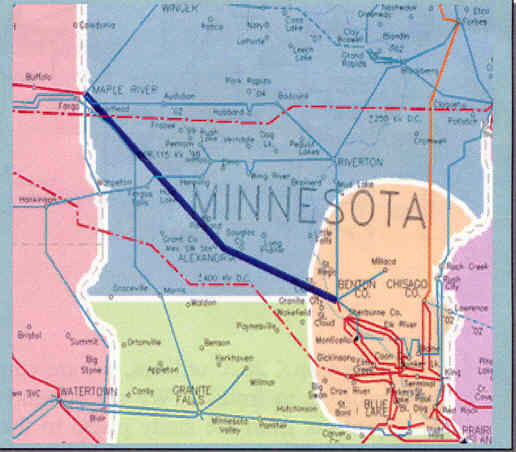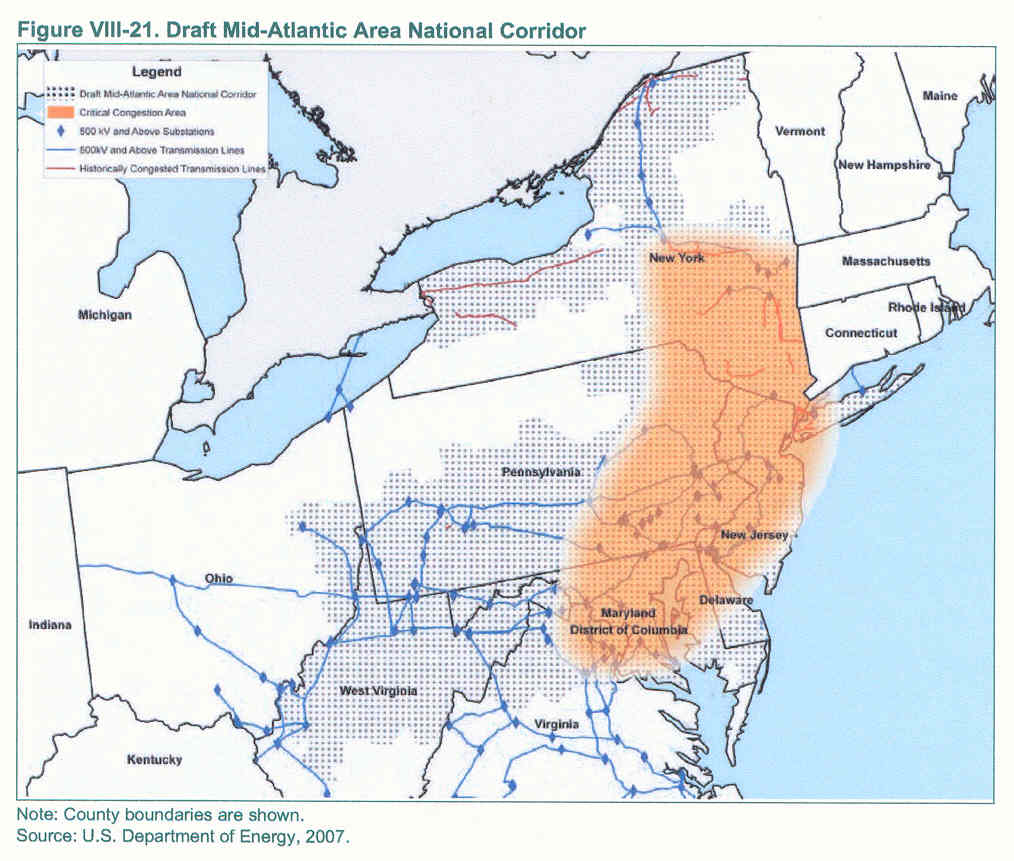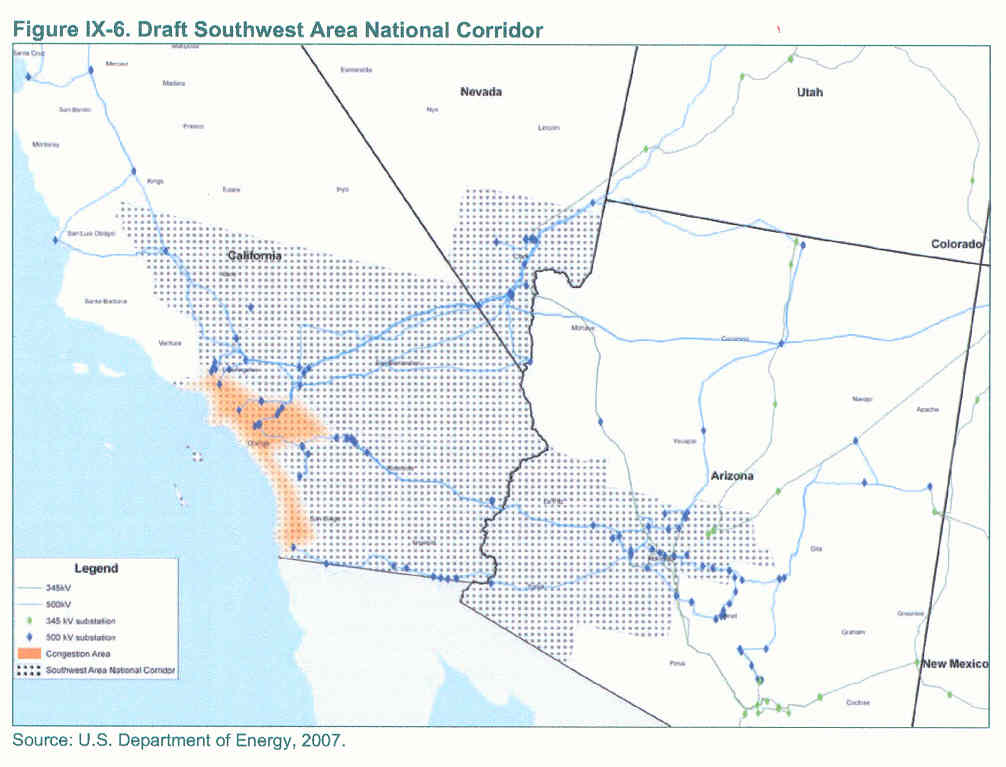70,000 notices to CapX2020 affected landowners
July 24th, 2007

Here comes CapX 2020!!! Notices are being mailed to 70,000 landowners affected by the CapX 2020 transmission proposal (if you click to go to their site, be forwarned, it’s severely constipated). It seems to me that 70,000 number is a bit shy of what it should be.
To get to the CapX2020 docket go to www.puc.state.mn.us and then to “eDockets” and then to “Search Documents” and then plug in docket 05-1115.
Here are the routes they’re proposing, shown by the dashed lines.
Let’s start with the SW MN to Prairie line, which will be continued on to Rochester and Lacrosse. Here’s SW to Prairie Island, and note how the Big Stone plant’s transmission ties right in (the SW line enables construction of the Big Stone II coal plant and transmission of Big Stone coal-generated electricity):
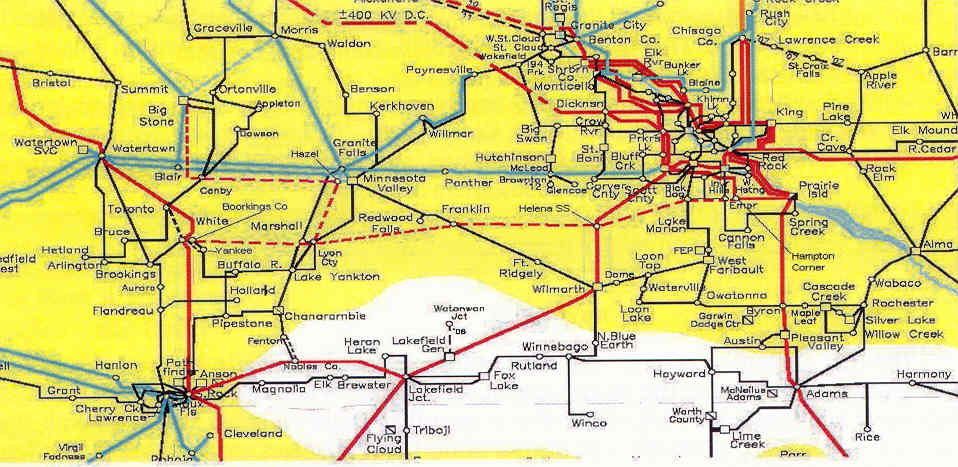
Utility contact info for that segment:
Brookings – SE Twin Cities (345-kV)
· Craig Poorker & Randy Fordice
· 888-473-2279
· brookingsinfo@capx2020.com
And here’s the one from Prairie Island to Rochester to LaCrosse and beyond:
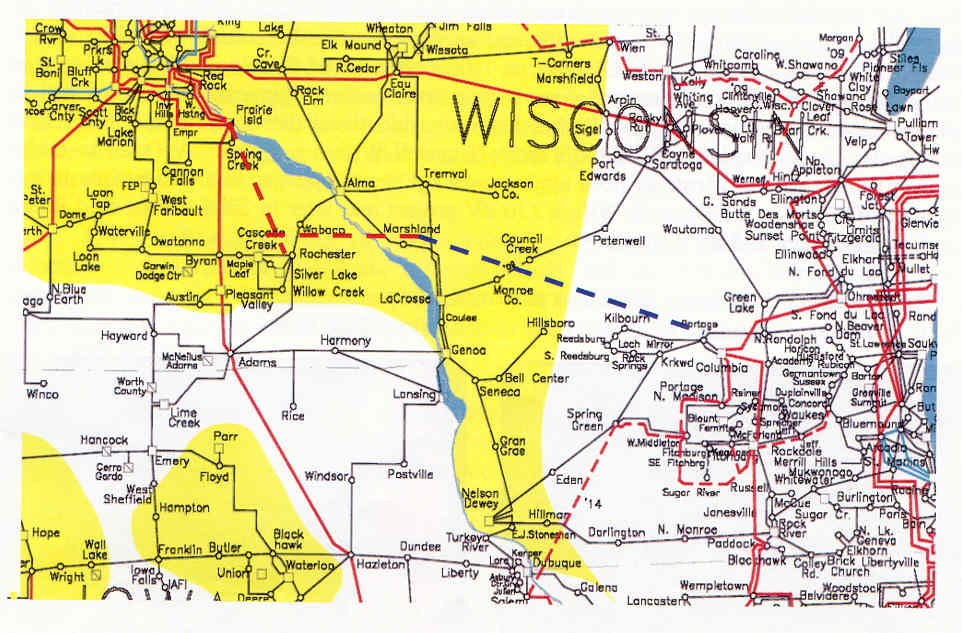
Utility contact info for this segment:
SE Twin Cities – Rochester – La Crosse (345-kV)
· Pam Rasmussen: 800-238-7968
· Chuck Thompson: 866-876-2869
· lacrosseinfo@capx2020.com
Here’s the one from the coal fields of ND to Fargo to the NW Metro:
Utility contact info for this segment:
Fargo – Alexandria – St. Cloud – Monticello (345-kV)
· Darrin Lahr & Jim Musso
· 866-876-2869
· fargoinfo@capx2020.com
As we say in transmission, it’s all connected. CapX2020 — it’s not needed. It does nothing for Minnesota, just passes through, and serves only the coal interests that are building new coal plants. Without these lines, they cannot build more coal. It’s that simple.
These lines are brought to you by those “environmental” groups who did the TRANSLink deal:
And special thanks to Bill Grant and Beth Soholt of the Waltons/Wind on the Wires and George Crocker, North American Water Office, for ushering through the 2005 Transmission Ominous Bill from Hell:
Gee thanks… I’m sure these 70,000 landowners will be pleased with what you’ve done…
CapX 2020 in the Beagle
June 14th, 2007

It’s about time, some serious attention paid to this huge group of 345kV transmission lines criss-crossing the state.  Red Wing and Prairie Island are the most affected of all Minnesota communities, because we have three lines in the CapX plan, one coming in from the southwest, one going south into Wisconsin, and another coming down from the Chisago substation. IS ANYONELISTENING????
Power line plan may be live wire
Mike Longaecker
The Republican Eagle – 06/14/2007Xcel Energy officials are gearing up to make a case that Minnesota’s electricity needs require a massive expansion of transmission lines.
Depending on the outcome, the 150-mile-long project could mean new power lines being draped over Red Wing.
The project would extend new high-voltage transmission lines from the Twin Cities to Rochester.
Xcel officials anticipate the line would head south through Hampton on its way to Rochester, though they won’t rule out a second option that would run lines east to the Prairie Island nuclear plant.
Utility officials will present their case — possibly by July — to the state’s Public Utilities Commission.
Notices to be sent
Before that hearing begins, Red Wing residents will be among the approximately 17,000 area landowners who receive notice of the project, an Xcel official said.
“We’re at the beginning of what will be a long and expensive and very open public process,†said Laura McCarten, co-executive director for what’s called the CapX 2020 initiative.
Preliminary cost estimates for the CapX 2020 project are at about $1.3 billion, she said. Xcel predicts that would mean about $1.50 more a month for the average customer.
McCarten said Department of Commerce figures show electricity use in Minnesota has doubled since 1980 but transmission infrastructure hasn’t kept pace.
Is it needed?
Opponents of the project reject Xcel’s claim that the state’s electricity needs will soon outstrip the ability to deliver them. The PUC will be tasked with sorting that out, but one Red Wing resident has her doubts that the need even exists.
Carol Overland, an advocacy attorney on utility, regulatory and land-use issues, said Xcel overestimates the need, citing a North American Electric Reliability Council study showing demand in the immediate area growing by .6 percent.
She suspects the project — to be linked with other transmission lines — is instead using Minnesota land as a conduit to provide more power to the East Coast.
“Is that something that should be built on the backs of Minnesota ratepayers and landowners?†Overland said.
She also noted that a Minnesota Supreme Court decision limits transmission projects to existing corridors. That would likely mean the project following the alternate route to Prairie Island, she said.
Also watching the CapX 2020 project closely is the Prairie Island Indian Community. Attorneys for the tribe filed a letter with the PUC, stating that the project could have “a significant potential impact, whether direct or indirect.â€
In the March 2007 letter, tribal officials said they would reserve judgment on the project, but pledged to be heavily involved in a process McCarten said could take more than a year.
Statewide transmission efforts received a major boost from the Legislature during the 2005 session.
Sen. Steve Murphy, DFL-Red Wing, said he sees a need for the new power lines, especially considering the new wind generation sources that were mandated through a renewable energy standard signed into law this year.
“If we’re going to be a leader in this state in renewable energy,†Murphy, an Xcel employee said, “you’ve got to move it from where you generate to where you need it.â€Â
Comment on proposed Transmission Corridors
April 29th, 2007
.
Transmission lines may be coming your way, through federal pre-emption of state processes that give transmission lines the scrutiny they require. They’re working to transfer jurisdiction of transmission siting out of the hands of the states and into the hands of FERC, we’ve been hearing about this for a while, they’ve got the authority to do it, and now there are specific transmission corridors proposed. Well, as specific as you can get with a 100-200 mile wide corridor!
Is this what you want? Do you want the feds to have power of eminent domain to give utilities what they want — YOUR LAND? Do you want these National Transmission Corridors through your yard? Do you want them to get away with characterizing transmission of market transactions, bulk power transfer, as necessary for “national security?”
NATIONAL ELECTRIC TRANSMISSION CORRIDORS WERE ANNOUNCED LAST WEEK. NOW’S THE TIME TO REGISTER YOUR COMMENTS!
Public Comment Period is 60 days, beginning on April 26, 2006, and ending on (I think) June 25, 2007 (depending on how they count!). They claim that comments received or postmarked within the 60-day comment period will be considered, but I recommend making sure it GETS THERE by the deadline, I hate to rely on their statement about postmarks!
They have the above Public Comment Form on their site, and if you use this, I’d recommend printing it out so you have a record of it.
They ask that you specify the docket you’re Commenting on, i.e., Docket No. 2007-OE-01 (the draft Mid-Atlantic Area National Corridor), comments must be marked “Attn: Docket No. 2007-OE-01” and for Docket No. 2007-OE-02 (the draft Southwest Area National Corridor), comments must be marked “Attn: Docket No. 2007-OE-02.”
==========================
This is the proposed Mid-Atlantic Area National Corridor, I’d heard questions about this from Pennsylvania and New York, and it seems it covers half the state of Delaware (that doesn’t take much):
This is the proposed Southwest Area National Corridor:
The U.S. Department of Energy (DOE) is holding three public meetings on the two draft National Corridor Designations announced on April 26, 2007. The meetings are being held in two eastern locations and one southwest location, and they’re not readily accessible. The one in Washington, D.C. is held at a hotel where parking is $18/day and not on a Metro stop — it seems that there MUST be somewhere with a sufficiently large meeting room with parking and more direct accessibility — but who wants that pesky “public” there anyway!
Two public meetings will be held on Docket NO. 2007-OE-01 (the Draft Mid-Atlantic Area National Corridor Designation) – in Arlington, VA, on May 15, 2007, and in New York, NY, on May 23, 2007 – and one public meeting will be held on Docket NO.2007-OE-02 (the Draft Southwest Area National Corridor Designation) – in San Diego on May 17, 2007.
Arlington, VA Meeting on May 15:
Doubletree Hotel Crystal City-National Airport
300 Army Navy Drive
Arlington, VA 22202-2891
Phone: 703-416-4100
(hotel says parking costs $18!)
San Diego, CA Meeting on May 17:
Manchester Grand Hyatt San Diego Hotel
One Market Place
San Diego, California 92101
Phone: (619) 232-1234
New York, NY Meeting on May 23:
Park Central New York Hotel
870 Seventh Avenue at 56th Street
New York, NY 10019-4038
Phone: 212-247-8000
From their blurb:
DOE invites all interested parties to participate in the public meetings and to provide oral and written comments at these sessions in addition to submitting comments in response to the Federal Register Notice on Draft National Interest Electric Transmission Corridor Designations.
Agenda
Each of the three meetings will have the same basic format:
9:00 a.m. – 10:00 a.m. Registration Desk Open
10:00 a.m. – 10:30 a.m. DOE Opening Remarks and Presentation
10:30 a.m. – 12:00 p.m. Public Comments
12:00 p.m. – 1:30 p.m. Lunch (on participants own)
1:30 p.m. – 3:30 p.m. Public CommentsAdvance registration is not required to attend. However, participants who would like to provide oral comments must sign up in advance.
Sign-up to Provide Public Comments at the Meeting
If you would like to present oral comments at one of the meetings, you must register in advance. The opportunity to comment will be limited to 2 minutes per presenter. Those wishing to provide oral comments will present on the day of the meeting in the order in which they are received. Sign-up here to provide public comments.
Each public meeting will be transcribed and the transcript will be posted on the web site following the meeting. To supplement oral comments, written comments may be submitted.
For More Information
For general information on the Draft National Interest Electric Transmission Corridor Designations, please visit http://nietc.anl.gov.
Contacts
Poonum Agrawal (Technical Contact)
Manager
Markets & Technical Integration
Office of Electricity Delivery and Energy Reliability
U.S. Department of Energy
Phone: (202) 586-6048
Email: poonum.agrawal@hq.doe.govLauren Giles (Logistics)
Program Manager
Energetics Incorporated
Phone: (410) 953-6250
Email: LGiles@energetics.com
Here’s a link to PJM Transmission Maps. Most of the affected area is in PJM, though not all.
Hot off press – CRVC granted Intervention
April 24th, 2007
Just in today — the “Second Order of Intervention” granting Concerned River Valley Citizens Intervention status:
And check this Memorandum, which simply must be read in its entirety to appreciate:
Because of the concerns Concerned River Valley Citizens (“CRVCâ€) raised in its filings as to the extent of public participation if its motion for intervention as a party were not granted, a few points deserve special emphasis.
It bears noting that while the Administrative Law Judge had concerns as to who might make an appearance on behalf of CRVC in these proceedings there was never a serious question as to whether, as an association of affected landowners, CRVC had a legal right to raise questions or be heard as to the proposed project. Similarly, there was never a risk that the views of CRVC would not be sought, or integrated in a meaningful way, into hearing record. Likewise, it is free from doubt that Mr. Neuman, Ms. Johnson or other affected landowners, could have intervened in their individual capacity, without counsel. The fact is that our system of due process delights in the contributions that genuinely motivated parties make toward building a record for later decision-making.
The much narrower item of concern for the Administrative Law Judge was whether Mr. Neuman or Ms. Johnson, neither of whom are attorneys, could permissibly make an appearance on behalf of CRVC – which is a corporate entity. The general, and more familiar rule, is that a corporation must be represented by an attorney in legal proceedings.
There is, however, an important exception to this general rule. The predecessor Environmental Quality Board2 had a specific representation rule for proceedings “involving … the routing of high voltage transmission lines†that is more generous and permissive than both the common law rule and the representation rule for contested cases under the Minnesota Administrative rocedures Act. Rule 1405.0600 permits “all persons†to be “represented by legal counsel, or by a person of their choice, or they may represent themselves.â€Â Under these same rules, the definition of “person†is broad enough to include corporate entities such as CRVC.Â
Because of these more generous rules, which are specific to these proceedings, granting CRVC’s request as it was submitted by its chosen representatives, is appropriate.
CRVC – unauthorized practice of law… NOT!
April 24th, 2007
And this is another aspect of the Chisago case that has me fuming! There’s yet another twist in the Chisago proceeding is the harassment of my former client, Concerned River Valley Citizens (CRVC). I’m glad I’m a step removed, because this is such flagrant _________ (your favorite invective here).
Earlier this month, CRVC’s Motion for Extension of Task Force was “taken under advisement,” and they received the most bizarre Order from the ALJ, directing them to respond to specific questions of the ALJ set out in Order point 3:
   3.   On or before 4:30 p.m. on Wednesday, April 18, 2007, a representative of the Concerned River Valley Citizens shall file responsive papers addressing the following matters:
a.   Whether either Mr. Neuman or Ms. Johnson is licensed to practice law in Minnesota or any other jurisdiction;
b.   Whether, in the view of the association, representation of Concerned River Valley Citizens by a non-attorney would amount to the unauthorized practice of law, as those terms are used in Rule 1400.5800;
c.   Whether, in the view of the association, retaining the services of a licensed attorney to appear on behalf of Concerned River Valley Citizens would be unduly burdensome;
d.   Whether the Concerned River Valley Citizens, if granted intervention as a party, would seek access to confidential trade secret data; and,
e.   Whether a more limited role than intervention, under Rule 1400.7150, might meet the needs of Concerned River Valley Citizens.
Seems to me that this is express notice to CRVC that they are being offered the “choice” of caving and relinquishing meaningful participation, or they’ll get only a “limited role.” Good thing I’m not representing them, because MY response would not be printable in this “family blog.”
Here’s the full Order:
Bill Neuman has taken the lead in CRVC’s Intervention, since they “passed me off” to the City, and he submitted the following responses to the ALJ:
II. CRVC POSITION ON ISSUES
A. Whether either Mr. Neuman or Ms. Johnson is licensed to practice law in Minnesota or any other jurisdiction.
CRVC objects to this question as it infers a requirement that it be represented by a licensed attorney. Maintaining that objection, neither Mr. Neuman nor Ms. Johnson are attorneys licensed to practice law in Minnesota or any other jurisdiction. There is no authority in rule or statute to support the notion that licensure is required for an individual to represent themselves or a non-profit organization of which they are an officer. Further, the statutory and regulatory policy of encouraging public participation requires that parties be afforded the opportunity to represent their interests.
B. Whether, in the view of the association, representation of Concerned River Valley Citizens by a non-attorney would amount to the unauthorized practice of law, as  those terms are used in Rule 1400.5800.
CRVC objects to this question, as it, again, infers a requirement that CRVC be represented by a licensed attorney. While maintaining that objection, representation of CRVC by a non-attorney does not amount to unauthorized practice. Rule 1400.5800 does not offer guidance as to the definition of “unauthorized practice,†which is correctly found in Minn. Stat. §481.02. CRVC notes that this statute draws a distinction between those corporations organized for pecuniary profit, and non-profits such as CRVC. Minn. Stat. §481.02, Subd. 2. The statute also specifies legal representation in “court†and does not address administrative proceedings. Parties may draw and submit documents without charge where they are officers of a corporation, as Ms. Johnson and Mr. Neuman are with CRVC. Neither Johnson nor Neuman are receiving payment for their work on this issue. Minn. Stat. §481.02, Subd. 3. Minn. Stat. §481.02, Subd. 1,Subd. 5. Further, it has long been agency practice that individuals and officers of non-profit corporations represent themselves before the Commission and the Environmental Quality Board, and before ALJs of the Office of Administrative Hearings. Departure from this practice would be a change of great magnitude and impact and would greatly limit the ability of the public to participate in dockets that have a direct impact on
their lives and property.Again, there is no authority in rule or statute to support the notion that licensure is required for an individual to represent themselves or a non-profit organization of which they are an officer. Further, the statutory and regulatory policy of encouraging public participation requires that parties be afforded the opportunity to represent their interests.
C. Whether, in the view of the association, retaining the services of a licensed attorney to appear on behalf of Concerned River Valley Citizens would be unduly burdensome.
CRVC objects to this question as it again infers a requirement that CRVC be represented by a licensed attorney and that an Order to that effect is contemplated. Maintaining that objection, CRVC states that retaining the services of a licensed attorney to appear on behalf of Concerned River Valley Citizens would be unduly burdensome, utterly unnecessary, and that any Order that CRVC must retain an attorney would be unreasonable. It should be noted that Minnesota does not offer Intervenor Compensation.
D. Whether the Concerned River Valley Citizens, if granted intervention as a party, would seek access to confidential trade secret data.
CRVC objects to this question because whether a potential party would seek access to confidential trade secret data is not a criteria for granting or denying intervention. Commission and OAH practice has long been to provide Intervenors with confidential trade secret data under a protective order, whether utility or non-profit intervenors. These agreements are routine. CRVC would obviously be bound by a confidentiality agreement. Further, there does not seem to be any confidential trade secret.
E. Whether a more limited role than intervention, under Rule 1400.7150, might meet the needs of Concerned River Valley Citizens.
CRVC objects to this question as it implies granting a limited intervention only, contrary to the policy goals of encouragement of public participation. Further, provisions of Rule 1400.7150 do not convey a right of participation. CRVC requires intervention with full-party status, as has been granted previously, because of the depth and breadth of issues raised, and that no other party adequately represents these interests.Â
I guess CRVC told the ALJ, huh!!!
The ALJ’s Order is unprecedented harassment of Intervenors and is an extreme example of the many attacks against public participation, the basic due process rights of people affected by all these infrastructure proposals. HOW DARE THEY!!!!
